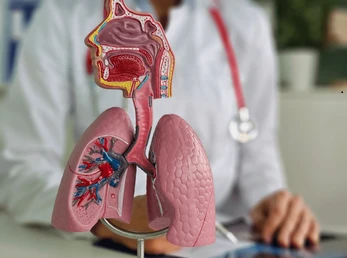Respiratory Conditions
Comprehensive information about respiratory disorders, their symptoms, causes, diagnosis, and treatment options to help you understand and manage lung health conditions effectively.
Understanding Respiratory Health
Respiratory conditions, also known as lung diseases, encompass a wide range of disorders that affect the lungs and breathing passages. These conditions can significantly impact your ability to breathe properly and maintain adequate oxygen levels in your blood, affecting your overall quality of life and daily activities.
According to the World Health Organization, respiratory diseases are among the leading causes of death and disability worldwide. Lung disease is the third-leading cause of death in the United States, and respiratory problems are also leading causes of death in infants. Early detection, proper diagnosis, and appropriate treatment are crucial for managing these conditions effectively.
3rd Leading
Cause of death in USEarly Detection
Improves outcomes
Common Respiratory Disorders
The most frequently diagnosed respiratory conditions
Asthma
Chronic condition causing airway inflammation, wheezing, and breathing difficulties.
ObstructiveCOPD
Progressive lung disease including emphysema and chronic bronchitis.
ProgressivePneumonia
Serious lung infection caused by bacteria, viruses, or other pathogens.
InfectiousCystic Fibrosis
Genetic disorder affecting lungs and digestive system with thick mucus production.
GeneticTypes of Respiratory Disorders
Categorized by their underlying mechanisms and characteristics
Obstructive Diseases
Conditions that make it difficult to exhale air from the lungs due to narrowed or blocked airways.
- Asthma
- COPD (Emphysema & Chronic Bronchitis)
- Bronchiectasis
Restrictive Diseases
Conditions that prevent the lungs from fully expanding, reducing the amount of air that can be inhaled.
- Pulmonary Fibrosis
- Asbestosis
- Silicosis
Infectious Diseases
Respiratory conditions caused by bacteria, viruses, fungi, or other pathogens.
- Pneumonia
- Tuberculosis (TB)
- Legionnaires' Disease
Malignant Conditions
Cancerous conditions affecting the lungs and surrounding tissues.
- Lung Cancer
- Mesothelioma
- Metastatic Cancer to Lungs
Symptoms and Warning Signs
Recognize the signs that require medical attention
Common Respiratory Symptoms
These symptoms may indicate various respiratory conditions and should be evaluated by a healthcare professional, especially if persistent or worsening.
Emergency Warning Signs
These symptoms require immediate medical attention as they may indicate severe respiratory distress or life-threatening conditions.
Causes and Risk Factors
Understanding what contributes to respiratory conditions
Environmental
Air pollution, occupational dust exposure, secondhand smoke, and allergens.
Lifestyle
Smoking tobacco, poor diet, lack of exercise, obesity, and workplace irritants.
Genetic
Family history, genetic mutations, and inherited susceptibility to conditions.
Infectious
Bacteria, viruses, fungi, and other pathogens causing respiratory infections.
Diagnosis and Tests
Physical Examination
Comprehensive assessment including listening to lung sounds, checking oxygen levels, and evaluating breathing patterns and chest movement.
Imaging Studies
Chest X-rays, CT scans, and MRI to visualize lung structure, detect abnormalities, and assess disease progression.
Pulmonary Function Tests
Spirometry and other breathing tests to measure lung capacity, airflow, and gas exchange efficiency.
Blood Tests
Arterial blood gas analysis, complete blood count, and inflammatory markers to assess oxygen levels and detect infections.
Sputum Analysis
Laboratory examination of mucus samples to identify infectious organisms and abnormal cells.
Bronchoscopy
Direct visualization of airways using a flexible tube with camera to examine lung tissue and collect samples.
Treatment Options
Medications
Bronchodilators, corticosteroids, antibiotics, and other medications to manage symptoms, reduce inflammation, and treat infections.
Oxygen Therapy
Supplemental oxygen delivery through various devices to maintain adequate blood oxygen levels and improve breathing.
Pulmonary Rehabilitation
Structured exercise programs, breathing techniques, and education to improve lung function and quality of life.
Surgical Interventions
Lung transplantation, tumor removal, and other surgical procedures for severe or advanced respiratory conditions.
Lifestyle Modifications
Smoking cessation, environmental control, dietary changes, and stress management to support respiratory health.
Living with Respiratory Conditions
Essential strategies for daily management and quality of life
Daily Management
- Take medications as prescribed
- Monitor symptoms daily
- Use peak flow meters
- Maintain sleep schedule
Environment
- Avoid triggers and allergens
- Use air purifiers
- Maintain clean spaces
- Monitor air quality
Emergency Prep
- Keep rescue medications
- Emergency contacts ready
- Know when to seek care
- Emergency supply
Support Systems
- Join support groups
- Communicate with family
- Work with healthcare team
- Consider counseling
When to See a Doctor
Ready to Start Nebulizer Therapy?
Our respiratory specialists are here to help you get started with nebulizer therapy and provide ongoing support for optimal treatment outcomes.
